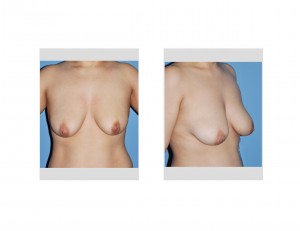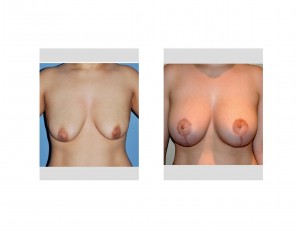Background: A woman’s breast is not a stable structure over her lifetime. It is exposed to many changes from its initial development throughout puberty to an older woman. Undoubtably the greatest changer of breast shape is pregnancy, causing gradual expansion and then a relatively rapid deflation. With this overall yoyo of breast shape comes loss of breast tissue and stretching of the skin as a consequence. When the process is repeated more than once, the loss of breast shape and position on the chest wall is inevitable.

When the nipple is at or below the lower breast fold, an implant alone is not going to be enough to restore an aesthetically pleasing position of the nipple on the breast mound. Implants simply do not create any substantial breast lifting effect, no matter what apatient hopes or has read. When this degree of breast ptosis exists, the need for a lift with an implant can not be avoided. While some patients do not desire a lift, they may elect to have an implant placed first to prove whether a lift is really ultimately needed. I am not opposed to this approach as long as patients do not confuse hope for oversight on my part afterwards.
Breast lifts come in a variety of types, differentiated only by the amount of scar they create and how much breast mound lifting is achieved and the nipple position is moved upward. To no surprise, there is a fairly direct correlation between the amount of scarring and the amount of overall breast lifting. The more scar that is created on the bottom of the breast below the nipple, the more lifting that is achieved.
Case Study: This 25 year-old Hispanic female wanted to improve her breast shape and size after having two children. She had lost much of her breast volume and developed a Grade III ptosis in both breasts. (nipple at or just below the lower breast fold) In discussing a combination implant and lifting procedure, the concerns about scarring were stressed. This is of particular relevance in patients with increasing skin pigmentation. As skin pigment increases, the more the scar may be noticeable or develop some hyperpigmentation after surgery.



Case Highlights:
· Reshaping of the deflated and sagging breast requires a combination of implant volume addition and nipple lifting and skin tightening manuevers.
· Scars are an inevitable consequence of the breast lift part of the procedure and must be considered an aesthetic trade-off of thecombination breast reshaping procedure.
· Breast reshaping through a combination lift and implant placement is one of the hardest body contouring procedures to perform and the need for revision for optimal results is common.
Dr. Barry Eppley
Indianapolis, Indiana


